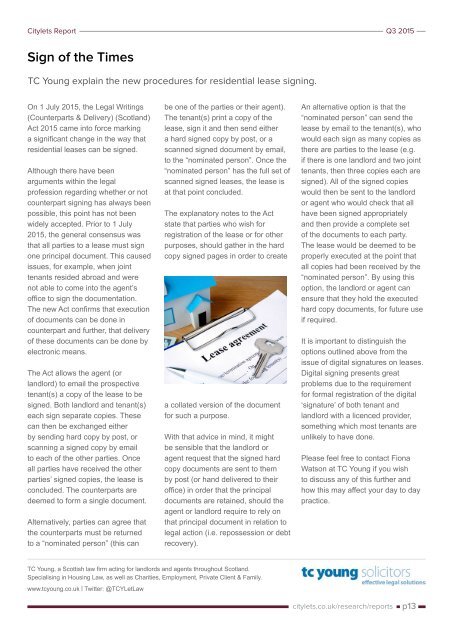Treating Symptoms Damaging Cures?
1j6TOnA
1j6TOnA
- No tags were found...
Create successful ePaper yourself
Turn your PDF publications into a flip-book with our unique Google optimized e-Paper software.
Citylets Report Q3 2015<br />
Sign of the Times<br />
TC Young explain the new procedures for residential lease signing.<br />
On 1 July 2015, the Legal Writings<br />
(Counterparts & Delivery) (Scotland)<br />
Act 2015 came into force marking<br />
a significant change in the way that<br />
residential leases can be signed.<br />
Although there have been<br />
arguments within the legal<br />
profession regarding whether or not<br />
counterpart signing has always been<br />
possible, this point has not been<br />
widely accepted. Prior to 1 July<br />
2015, the general consensus was<br />
that all parties to a lease must sign<br />
one principal document. This caused<br />
issues, for example, when joint<br />
tenants resided abroad and were<br />
not able to come into the agent’s<br />
office to sign the documentation.<br />
The new Act confirms that execution<br />
of documents can be done in<br />
counterpart and further, that delivery<br />
of these documents can be done by<br />
electronic means.<br />
The Act allows the agent (or<br />
landlord) to email the prospective<br />
tenant(s) a copy of the lease to be<br />
signed. Both landlord and tenant(s)<br />
each sign separate copies. These<br />
can then be exchanged either<br />
by sending hard copy by post, or<br />
scanning a signed copy by email<br />
to each of the other parties. Once<br />
all parties have received the other<br />
parties’ signed copies, the lease is<br />
concluded. The counterparts are<br />
deemed to form a single document.<br />
Alternatively, parties can agree that<br />
the counterparts must be returned<br />
to a “nominated person” (this can<br />
be one of the parties or their agent).<br />
The tenant(s) print a copy of the<br />
lease, sign it and then send either<br />
a hard signed copy by post, or a<br />
scanned signed document by email,<br />
to the “nominated person”. Once the<br />
“nominated person” has the full set of<br />
scanned signed leases, the lease is<br />
at that point concluded.<br />
The explanatory notes to the Act<br />
state that parties who wish for<br />
registration of the lease or for other<br />
purposes, should gather in the hard<br />
copy signed pages in order to create<br />
a collated version of the document<br />
for such a purpose.<br />
With that advice in mind, it might<br />
be sensible that the landlord or<br />
agent request that the signed hard<br />
copy documents are sent to them<br />
by post (or hand delivered to their<br />
office) in order that the principal<br />
documents are retained, should the<br />
agent or landlord require to rely on<br />
that principal document in relation to<br />
legal action (i.e. repossession or debt<br />
recovery).<br />
An alternative option is that the<br />
“nominated person” can send the<br />
lease by email to the tenant(s), who<br />
would each sign as many copies as<br />
there are parties to the lease (e.g.<br />
if there is one landlord and two joint<br />
tenants, then three copies each are<br />
signed). All of the signed copies<br />
would then be sent to the landlord<br />
or agent who would check that all<br />
have been signed appropriately<br />
and then provide a complete set<br />
of the documents to each party.<br />
The lease would be deemed to be<br />
properly executed at the point that<br />
all copies had been received by the<br />
“nominated person”. By using this<br />
option, the landlord or agent can<br />
ensure that they hold the executed<br />
hard copy documents, for future use<br />
if required.<br />
It is important to distinguish the<br />
options outlined above from the<br />
issue of digital signatures on leases.<br />
Digital signing presents great<br />
problems due to the requirement<br />
for formal registration of the digital<br />
‘signature’ of both tenant and<br />
landlord with a licenced provider,<br />
something which most tenants are<br />
unlikely to have done.<br />
Please feel free to contact Fiona<br />
Watson at TC Young if you wish<br />
to discuss any of this further and<br />
how this may affect your day to day<br />
practice.<br />
TC Young, a Scottish law firm acting for landlords and agents throughout Scotland.<br />
Specialising in Housing Law, as well as Charities, Employment, Private Client & Family.<br />
www.tcyoung.co.uk | Twitter: @TCYLetLaw<br />
citylets.co.uk/research/reports<br />
p13


